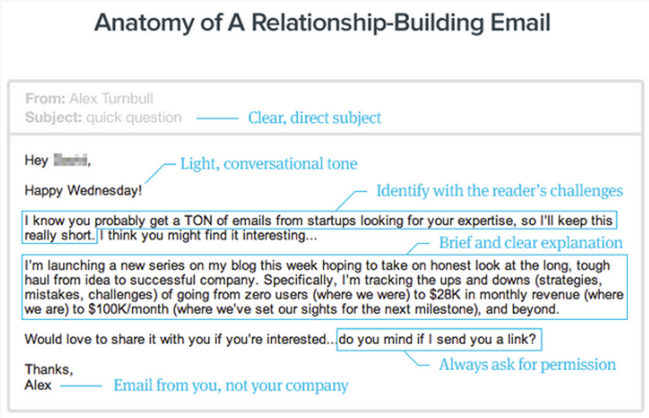What makes outreach different to traditional PR?
PR has traditionally involved communicating brand stories to the press through formal press releases and press kits to raise brand awareness and establish credibility. These would be blanket communications, with little personalisation.
With the exception of news announcements, this kind of brand-centric broadcasting has increasingly become prime material for the digital trash can. Instead, publishers want stories and other content that offer something genuinely useful for their audiences, whether this is the results of a recent survey, a beautiful series of illustrations or a guide to accomplishing a particular goal.
Furthermore, in line with how consumers now expect a growing amount of personalisation in their interaction with brands, journalists and bloggers expect PR professionals to demonstrate a real understanding of their work and audience. No more blanket emails. The successful and sustainable way forward is through genuine relationships between you and your contact.
Digital PR & Outreach is all about building these relationships – ones rooted in mutual benefit for both brand and publisher. With outreach, this mutual benefit is traditionally created by a tangible exchange: a piece of content in exchange for a link or social mention. With the growing convergence of digital PR, content marketing and SEO, achieving any form of coverage for a content piece from a top quality publication is considered of value to brand credibility.

How digital PR and content marketing are connected
With the rising expectations of publishers and audiences alike that brands offer more than just promotional chat, the role of content strategy moves to centre stage.
A content strategy involves determining the direction and boundaries for the creation and promotion of content in line with the brand’s business goals. A good content strategy focuses on the sweet spot between a user’s interests and needs and those goals. Users consist of both target customers, but also influencers like bloggers and journalists.
A key part of developing a content strategy is achieving a clear understanding of the existing content environment relating to your business area. This involves exploring the following:
- Who is prominently writing and talking about themes relating to your sector?
- What topics are proving most popular?
- What’s the most common tone of voice used across this content?
- Which formats and mediums do audiences in your niche like the most?
It’s a responsibility of the digital PR specialist to familiarise themselves thoroughly with the answer to the first question on this list: Who is talking about your sector? Identifying influential writers and speakers is important for developing a strong contact list, as we shall look at later, but there’s more to be gained from understanding who these people are and what they do.
By exploring the existing work of a particular journalist or blogger, you can sketch a fairly clear picture of the sorts of content likely to appeal to them and their audience. Building this understanding early on can help your team create content in a way that’s most likely to appeal to your primary outreach targets.

Optimising content for outreach
Keeping your promotional goals in mind during ideation and content production is a valuable way of sense checking ideas.
You ideally want to be able to distill the core premise of every content piece into a single clear statement: the elevator pitch. If too complicated, you’re likely to struggle with communicating the concept in an engaging way when outreaching.
Ask yourself: What’s the hook? Why would [X] write about this?
X being your target publication/journalist/blogger/influencer.
When you spend as much time exploring content as we do, you quickly spot trends in the sort of thing that, regardless of theme, gains coverage more readily than others. They include:
Maps
- Evening Standard: “New Interactive map of 100,000 photos and videos reveal ‘lost London’ in the Victorian Era“. Map by London Metropolitan Archives.
- Vice: “The Best Visualization of the Internet’s Submarine Backbone Yet“. Map by Builtvisible
- Forbes: “Map Shows Whether Yankees Or Mets Winning Merchandise War In New York City”. Map by MitchellandNess.com http
New research/survey findings
- Fortune: ““Exclusive: This Is What Working Women Want Even More Than Equal Pay”. Survey by Fairygodboss
- Independent: “Almost half of parents prepared to pay £60 fines for taking their children on holiday during term time, reveals survey“. Survey by WorldFirst
- Travel Weekly: “AAA survey shows increased interest in national parks“. Survey by AAA
Data visualisations
- International Business Times: “Fast food portions and calorie content: How Australia measures up“, infographic by Compare the Market (AUS)
- The Washington Post: “The mathematically proven winning strategy for 14 of the most popular games“. Graphics from various sources.
- Life hack: “The Only Food And Wine Matching Guide You Will Ever Need” infographics by Wine Folly
Visual comparisons
- Mashable: “Experience the Controversial Art of Colorizing Photographs“. Visual by Pixart.
- BoingBoing: “Famous entreprenuers’ hits and misses visualized“. Visual by Fleximise
- The Huffington Post: “A Day in The Life Of 26 Famous Creatives“. Visual by Podio.
As you’ll have noticed, visual content is the dominant approach here. If you have the resource available to create this sort of work and your goal is media coverage, then it’s well worth investing in.
While your assets are in production, it’s time to line up and expand your contact list.

Creating your contact list: finding the right publishers to target
There are a number of key tools that can help you find the right publications and people to outreach to – people who write for prominent sites with a demonstrated interest in the topic area your content broaches. Here are our favourites:
Google News & Site Search
Searching Google News for your topic is a simple way of identifying publications and authors with an interest in your subject. Once you’ve identified a website that has recently published related content, do a site search to evaluate just how often they write on the topic and in what ways. This will also highlight other writers on the site to potentially contact.
Buzzsumo
Buzzsumo is an excellent content analytics tool that allows you to explore top performing content for any topic or on any domain from the past year. Their influencer feature helps you identify influential bloggers, journalists and regular people on twitter for any given topic and add them to custom outreach lists. They have a dozen more features worth raving about which I won’t go into here, but it’s well worth having a poke around if you haven’t already.
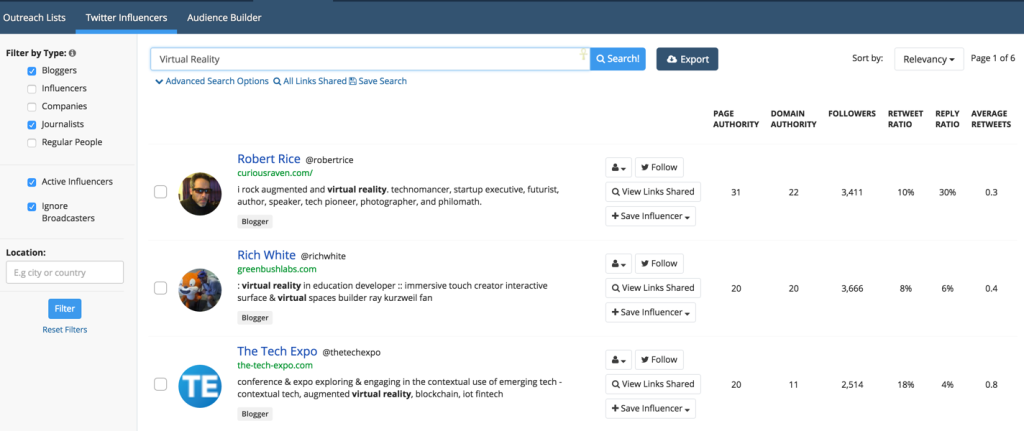
Media & journalist databases
Platforms like Muckrack and Gorkana exist to connect PR and Marketing professionals with relevant journalists, for a fee. They also offer media alerts that help you understand in real time what journalists are looking for and the conversation they’re having.
Hunting down and keeping track of contact details
Finding the right person to outreach to is often only half the battle. You also need to hunt down their contact details, typically in the form of an email address.
There are a variety of free and largely self-explanatory tools available to help you do this:
Remember to keep track of contact details you collect across different projects, so that you don’t find yourself wasting time looking for the details of someone you once emailed but can’t find in your sent box. Hubspot’s free CRM web app is an extremely easy and useful tool for the job – highly recommended to anyone in outreach or sales.
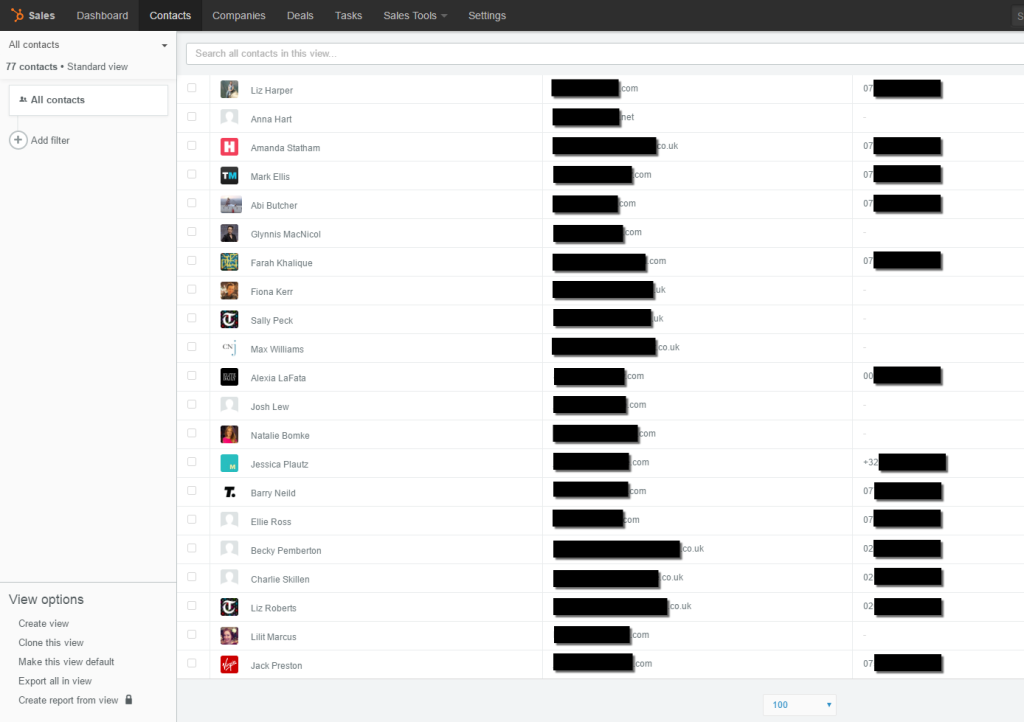
With your list assembled, it’s time to look at how to ask for what you want.

Making contact: tactics and best practice
Journalists and popular bloggers receive up to hundreds of pitches daily and will spend the bare minimum time assessing each one. With their inboxes stuffed to the brim, your email needs to work extremely hard to get on your contact’s radar. As such, be grateful to receive any kind of response, even if it’s a quick ‘no thanks’.
That said, there are ways to stand out from the noise, and a lot of the time it boils down to three basic principles in your approach: Relevance, personalisation and concision.
1. Personalisation
This is where a lot of people typically go wrong. A quick google search will bring up numerous outreach scripts with bold claims of 80-something perfect success rates and what not. Avoid them.
What these scripts by and large lack is a level of personalisation that demonstrates to the recipient that you have emailed them specifically, and not just sent out a mass email. Nothing in the email above indicates who Alex is speaking to and why they, personally, would find the blog series interesting.
Your job is to convince the recipient that you have something they should see. Personalisation is how you answer the implicit question of ‘what’s in it for me?’. To do so successfully, you need to demonstrate why your content or message is relevant.
2. Relevance
There are different ways to use relevance in your outreach communications, but it often just involves demonstrating that you’ve done your homework:
- Do you know what they like to write about?
- Do you know what media types they like to post, e.g. maps, infographics, photo series?
- Do you know who their target audience is
- Why would their target be interested in what you’re offering?
You don’t want to include the answers to all of these questions in your email, but you do want to highlight an understanding of one to indicate why you believe they would be interested in your content or idea. If you can’t make a clear connection between your content and theirs, you’re probably barking up the wrong tree.
Another way in which relevance can improve your chances when outreaching is through piggybacking on popular news or upcoming events.
The former is known as newsjacking, and involves positioning your idea or content piece in relation to a trending story, playing on any tangential relevance.
A lovely example of newsjacking happened recently in response to the Pokémon Go craze. The game requires players to hunt down wild Pokémon as well as walk up to 10km to hatch a Pokémon egg. Indiana-based dogs home The Muncie Animal Shelter took to social media to offer up their dogs for players to walk while they play [i]. The response was hugely positive, securing not only plenty of new dog-walkers, but also substantial international news coverage.
You don’t need to wait for the next big craze to find a newsjacking opportunity. Keep your eyes peeled for news stories, big and small. For example, if you’re seeking coverage for a survey about unused properties and journalists are reporting on a slump in a local property market, you’ve got a clear in.
The best way of finding these opportunities is by setting up google alerts or the likes for your topic area or industry. This will bring fresh trending stories straight to your inbox.
Alternatively, journalists often put out requests on twitter under the hashtag #journorequest, looking for very specific information, comments or contacts:
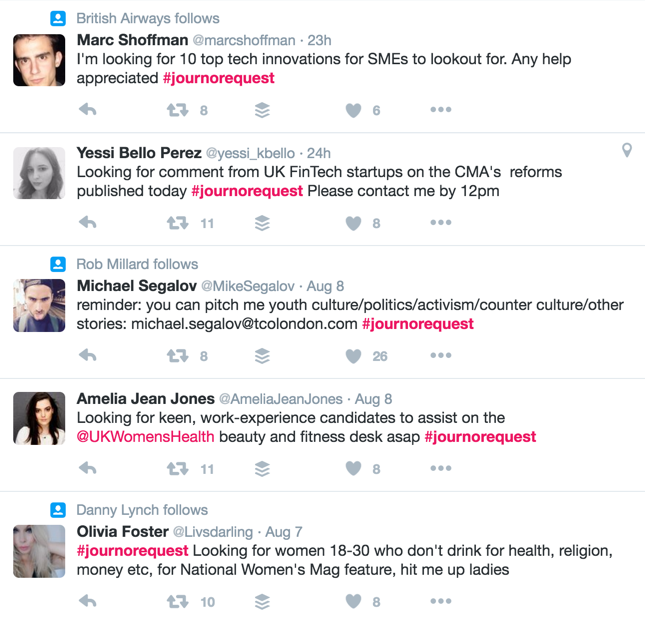
Routinely monitoring these requests is an easy way of finding new opportunities, as well as potential contacts for future content.
Finally, create a schedule of all of the different “international [x] day/week/month”, big events and seasonal trends, such as wedding season. Communicating the connection between one of these events and your content secures its relevance.
3. Concision
Being concise comes back to the point that journalists and bloggers are busy people with very full inboxes. Get straight to the point and give them what they need.
Avoid silly puns and cheesy attempts at getting their attention in your email’s subject line (unless this is the style of their own writing). What would their story’s headline look like? Write your emails in a way that requires recipients to think as little as possible. We find including the asset type in your subject line works well, e.g.:
Subject: Parents willing to pay fee for term-time holidays [survey results]
In the name of ease and time saving, always include the asset(s) you’re promoting in your first email. The scripted outreach email we looked at above claims that you should ask permission before sending a link – this is absolutely the wrong way to go about it. You’re forcing the recipient to request access to the very thing you want them to promote, creating an unnecessary hurdle.
If the content you’re promoting is on your website, include the link. If it’s an image file, attach it there and then. If you have a selection of resources for the recipient, upload them all to Dropbox or the likes and include the access link in your email. You might even want to pre-emptively write up commentary from your brand or the brand you’re promoting, should a journalist seek a quote and attach that.
Your aim here is to keep your interactions as simple and concise as possible. The dream scenario is that you send one email to your contact and the very next day you see your idea of content piece featured in their work.
Remember to say thank you!
What this looks like in practice
Here’s a real-life example of how we would approach the task:
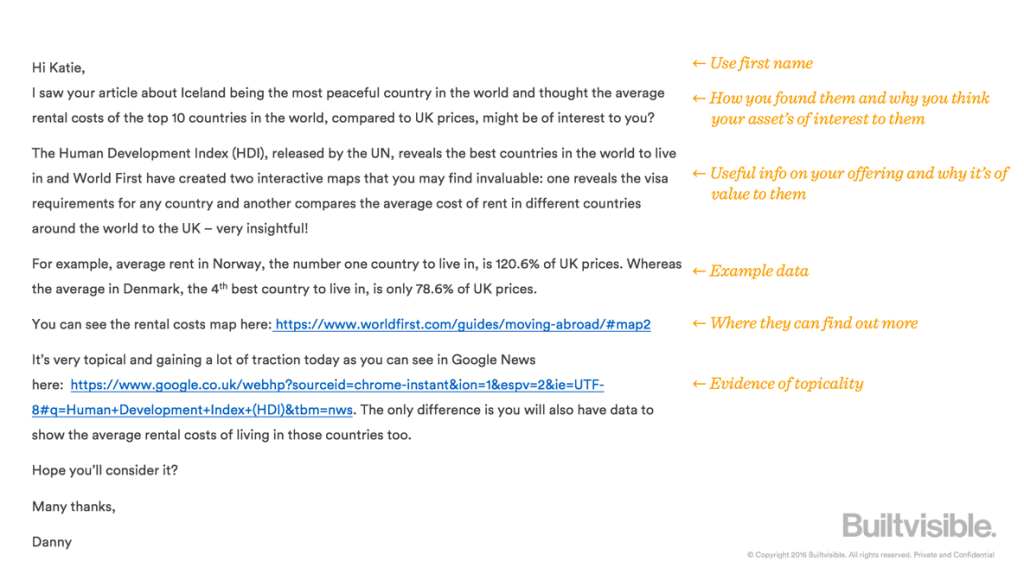

Tips for building relationships
Now that you’ve learnt about how best to outreach to journalists and bloggers, it’s worth spending some time considering how you can turn one-off exchanges into a genuine relationship of value to both parties.
Building relationships with members of the press, influencers or bloggers is, at the end of the day, just like building relationships with any other person. It requires a level of commitment and commonality.
An important thing to bear in mind is that they are human. Don’t be intimidated by their job title. Treat them with respect but also as you would someone you met at a networking event. Identify your common ground and use that to build the relationship.
Here are some ideas to get you going:
- Follow them on Twitter & LinkedIn. Following them will help you to learn more about their interests, but it will also help you stand out against the many other people who email their content, without further interest in the recipient.
- Send them something that isn’t a pitch – something you’ve spotted that you think they’ll like which isn’t yours. This shows that you’re genuinely interested in being useful to them. You can cement this further by including “no reply needed” in your email. This is about them, not you.
- Meet them! (I know, what is this crazy IRL nonsense). Ask them to go for a coffee somewhere convenient for them or attend an organised event, like the ones help by Gorkana. Putting a face to your name not only helps to build trust but it’s a great opportunity for you to get a better understanding of the likes, dislikes and needs of your contacts, which can make both of your lives easier in the future
- Finally, if you want to really stand out, consider sending a gift to get their attention. We’ve had success in the pass by sending the press a wonderful box of chocolates wrapped in a printout of the digital poster we were promoting. While this probably isn’t the most cost-effective approach for your mainstream outreach and relationship building, it’s worth considering for high-value campaigns and projects in need of that little bit extra.
We hope you’re now feeling ready and raring to go and secure your work and your brand some excellent coverage. Do let us know how you get on!
If you have any questions about digital PR & outreach or have come up against any particular hurdles that aren’t explored in this guide, feel free to tweet us or get in touch through the site. Remember, there are no guarantees when it comes to PR, it’s all about improving your chances. We wish you the best of luck.
